










Minimization, Closure Proofs, Regular Expressions
CS154
Chris Pollett
Feb. 13, 2013











CS154
Chris Pollett
Feb. 13, 2013
The first procedure for minimizing finite automata was given in Huffman 1954 (J. Franklin Institute. Vol 257. Iss. 3-4).
Our procedure above probably runs in quadratic time, the best known algorithm is `O(n log n)` due to Hopcroft 1971.
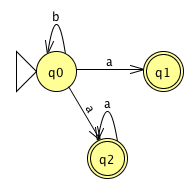
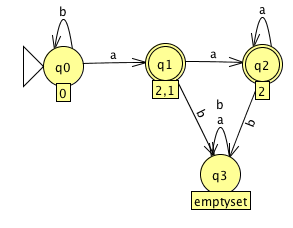
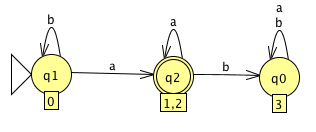
Problem 3. Apply the Cartesian product construction to (i) and (j) of exercise 1.6 to obtain an automata recognizing the union of their languages.
Answer. The following is an automaton which recognizes strings every odd position is a 1 (solving i):
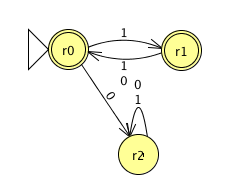
And the following is an automaton which recognizes those string which have at least two 0's and at most one 1 (solving j):
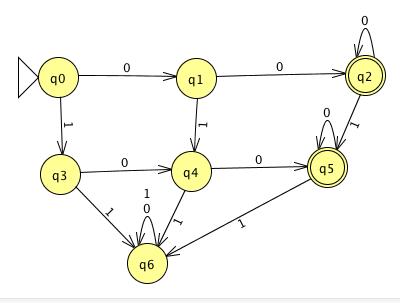
The machine coming from the Cartesian product construction where we consider only those states which are reachable from the start state is:
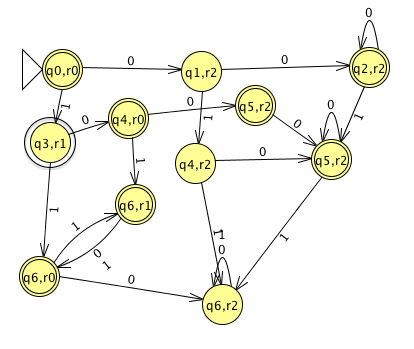
Problem 4. Consider the variant of Exercise 1.38 where rather than being in the language occurs if every possible state that M could be in after reading input x is accepting, we instead only require more than half of the states be accepting. Prove that the resulting class also recognizes exactly the regular languages.
Answer. Let PReg (probabilistic regular) denote the class of languages recognized by machines of the above kind. There are two parts to this problem: We need to show Reg `subseteq` PReg and PReg `subseteq` Reg.
The fact that we used the word "exactly" requires us to prove both directions. To see Reg `subseteq` PReg, let
`L` be a regular language. By definition, `L=L(M)` for some DFA `M = (Q, Sigma, delta, q_0, F)`. Consider the
machine `N = (Q \cup {q'}, Sigma, delta', q_0, F)` where `delta'` and `F'` are defined as follows. For any `q in Q` and `a in Sigma` define `delta'(q, a) = {delta(q,a)}` this is a well-defined mapping from `Q times Sigma -> P(Q \cup {q'})`.
For we define `delta'(q, epsilon) = {q'}` for some new state `q'` not in `Q`. Define `delta'(q', x) = {q'}` for `x in Sigma cup {epsilon}`. Observe by induction that `delta'^\star(q, w) = E(delta^\star(q,w)) ={delta^\star(q,w), q'}` and so consists of at most one accepting state. Now notice
`w in L` iff `delta^\star(q_0,w) = f` for some `f in F` iff `delta'^\star(q_0,w) = {f,q'}` for some `f in F`.
If less than half the states in `delta'^\star(q_0, v) = {s,q'}` are accepting then none of them must be accepting. Hence `s !in F` so `v !in L`. Similarly,
if at least half of the states in `delta'^\star(q_0, v)` then `s in F`, so `v in L`. Therefore `N` shows `L` is in PReg. On the other hand, suppose `L` is a language in Preg via some machine `N`. Apply the Power set construction to `N = (Q, Sigma, delta, q_0, F)` to get a machine `M = (P(Q), Sigma, delta', {q_0}, F')`. Rather than define `F'` as in the original construction define
`F' = {X | X \subset P(Q) mbox( at least half of X elements are accepting)}`.
The resulting machine is a DFA recognizing the same language as `N`.
We say that `R` is a regular expression if `R` over some alphabet `Sigma` is:
We write `R^+` as a shorthand for `R\ R^star`. Notice also we tend to be lazy on parentheses even thought to be fully well-formed everything has to be completely parenthesized.
We write `L(R)` for the language given by the regular expression.
Regular expressions were first considered in Kleene (1956).
In older books, you sometimes see regular expressions called rational expressions.
In a programming language like say PHP or Perl you might use things like: "\.|\,|\:|\;|\"|\'|\`|\]|\[|\{|\}|\(|\)|\!|\||\&" to match against, for instance, the punctuation symbols you want.
If you want to see regular expressions gone wild check out the Perl solution to the 99 bottles of beer song.
The following identities (`equiv` here meaning have the same language) are not too hard to verify:
Viewing emptyset as `0`, empty string as `1`, concatenation as multiplication, union as plus, the above show the regular expressions are a so-called semi-ring, and perhaps motivates why they are sometimes called rational expressions. It is not a ring because given `R` we can't easily define a regular expression `R'` such that `R cup R' equiv emptyset`.
Semi-rings don't typically have a star operation (there is a something called a star semi-ring). To reduce to the situation where one can get rid of star, one can look at languages which have the finite power property. That is, languages for which `L^\star = epsilon cup L cup ... cup L^(n-1)` for some `n ge 1`. Algorithms for checking this property have been given by Hashiguchi and Simon.



Assume now the result holds for languages for which the total number of uses of union, `*`, or concatenation is at most `n`. Consider `R` a regular language of complexity `n+1`. There are three cases to consider:


